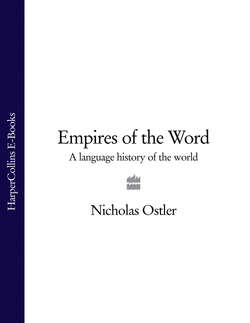Читать книгу Empires of the Word: A Language History of the World - Nicholas Ostler - Страница 44
China’s disciples
ОглавлениеAlthough China was always reserved in accepting any influence from foreigners, its smaller neighbours who achieved some level of settled civilisation and independent statehood were nothing like so circumspect in their acceptance of influence from China. The states and peoples of Korea, Japan and Vietnam adopted this position. Each of them spoke a language unrelated to Chinese. Each of them had to resist sporadic Chinese attempts at conquest (though Japan suffered this only in the first flush of Mongol imperialism). But each first learnt to read and write not in their own languages but in classical Chinese. And each developed writing systems for their own languages by transforming or supplementing the use of Chinese characters.
Unlike Chinese with Sanskrit and Pali, they each adopted vocabulary from Chinese as it was, regardless of the fact that it did not fit well within the sound systems of their own languages. For them, after all, China represented the fountainhead of advanced civilisation.* As a result their languages became full of Chinese loan vocabulary, modified for their own pronunciation, and have remained so ever since. They soon had as clear an appreciation of the meanings of the syllables they borrowed, and the characters associated with them, as the Chinese had themselves—indeed, perhaps clearer, since they also used the same characters to represent words in their own languages, related only by meaning.
This faithful adoption and incorporation of Chinese language has provided a useful time capsule of a kind for modern comparative research on the history of Chinese. These three ‘Sinoxenic’ dialects, Sino-Korean, Sino-Japanese, Sino-Vietnamese, are made up of syllables and words borrowed from Chinese. They are so complete that it is possible to use them to read out whole texts in wényán. As such, they have preserved an echo of Chinese as it was pronounced when the words were borrowed. In fact, in the case of Japanese—complex as ever—there are three distinct echoes: go-on, kan-on and tō-on, depending on whether the word was borrowed in the sixth century, the eighth century or early in the second millennium. So the Mandarin word nèi, ‘within’, written , is now noi, pronounced in the sixth tone in Vietnamese, nae in Korean and dai or nai in Japanese. These antiquated styles proved vital when in 1954 the Swedish scholar Bernhard Karlgren came up with a reconstruction of the sounds of seventh-century Chinese.35
This avid cultural discipleship of its neighbours could be considered a major secondary spread of the Chinese language. It is often compared to the role of Latin within English and other modern European languages, or Arabic within Persian and Turkish, but it is really more comparable with the fundamental role of Sumerian within Akkadian. Chinese was a language quite unrelated to its disciple languages, and totally unlike them structurally. Nevertheless, its writing system became the root of their literacy, its words became inescapable for any sort of educated discourse, and its literature was adopted as the foundation for their own education system.
With their neighbours so in awe of them, it must have been hard for the Chinese to see their superiority as anything but a universal, objective fact.
